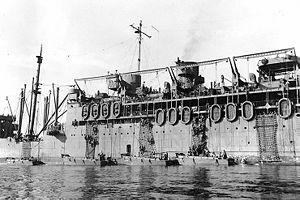Troopship

A troopship (also troop ship or troop transport or trooper) is a ship used to carry soldiers, either in peacetime or wartime. Operationally, troopships are normal ships, and unlike landing ships, cannot land troops directly on shore, typically loading and unloading at a seaport or onto smaller vessels, either tenders or barges.
Contents
History
The troopship has as long a history as passenger ships do, as most maritime nations enlisted their support in military operations (either by leasing the vessels or by impressing them into service) when their normal naval forces were deemed insufficient for the task. In the 19th century, navies frequently chartered civilian ocean liners, and from the start of the 20th century painted them gray and armed them; their speed, originally intended to minimize travel time, would prove valuable for outrunning submarines and enemy surface cruisers. HMT Olympic even managed to turn the tables, and rammed and sank a U-boat during one of its wartime crossings. Smaller or older liners with poorer performance were protected by operating in convoys.
Most major naval powers in the late 19th and early 20th centuries provided subsidies toward ensuring that they would have troopships available during times of war. The British government provided subsidies to both Cunard and the White Star Line toward the construction of liners (RMS Lusitania, RMS Mauretania, RMS Olympic, RMS Titanic, RMS Britannic) that could be converted into Armed Merchant Cruisers during wartime. When the vulnerability of these ships to return fire was realized most were used instead as troopship or hospital ships.
The RMS Queen Mary and the RMS Queen Elizabeth were two of the most famous converted liners of World War II. When they were fully converted, each of them could carry well over 10,000 troops per trip.
Designation
The designation HMT (His/Her Majesty's Troopship) would normally replace RMS (Royal Mail Steamship) or SS (Steamship) on ships converted to troopship duty with the Royal Navy of Great Britain. The US did not use an alternate designation, using USS as it does for any ship operated by its navy.
Recent use
In the era of the Cold War the United States designed the SS United States so that it could easily be converted from a liner to a troopship, in case of war. More recently, RMS Queen Elizabeth 2 carried 3000 troops to the Falklands War. By the end of the twentieth century, nearly all long-distance transfers of soldiers were being done by air in military transport aircraft.
Some notable troopships
- USS Agamemnon (ex Kaiser Wilhelm II)
- HMT Aquitania
- HMS Birkenhead
- SS Cap Arcona
- RMS Carmania Originally an Armed Merchant Cruiser but later carried over 10,000 troops over 3 trips.
- USAT Dorchester
- SS Great Eastern
- USS Henry R. Mallory
- USS Leviathan (ex Vaterland)
- RMS Laconia
- HMT Lancastria
- HMT Mauritania (Sister ship to Lusitania)
- SS Mendi
- HMT Olympic (Sister ship to Titanic)
- HMS Otranto
- SS Oxfordshire
- HMS Tamar
- USS Von Steuben (ex Kronprinz Wilhelm)
- HMT Rohna
References
Bibliography
- James Dugan, The Great Iron Ship, 1953 (regularly reprinted) ISBN 0-7509-3447-6
- Stephen Harding, Great Liners at War, Motorbooks Int'l, Osceola, WI, USA, 1997 ISBN 0-7603-0346
- Goron Newell, Ocean Liners of the 20th Century, Bonanza Books, USA, 1963 ISBN 0-517-03168X
Notes
| |
This section needs additional citations for verification. Please help improve this article by adding reliable references. Unsourced material may be challenged and removed. (April 2009) |
External links
de:Truppentransporter nl:Troepentransportschip ru:Войсковой транспорт
